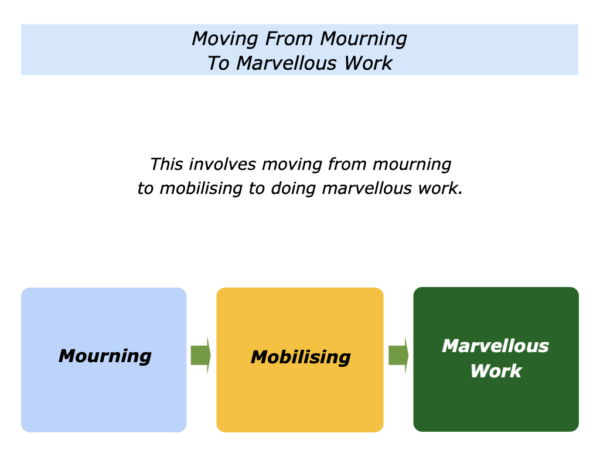
There are many ways to manage sorrow, setbacks and other challenging emotions. Each person will pursue their own journey in their own time to manage these feelings.
The classic change curve approach described by Elisabeth Kübler-Ross may apply for some people. What must be remembered, however, is that it described the stages experienced by people who knew they were coming to the end of their lives.
Everybody is different and will experience different emotions. It is important to respect the journey they are on. Some people experience grief, for example, and this can involve complex emotions.
This piece focuses on people who take a certain approach to managing challenging emotions. They move through the stages of mourning to mobilising their energy to doing marvellous work. Let’s explore these themes.
Mourning
Some people respond to painful events by going into a period of mourning. Feeling sorry for what has been lost or what could have been, they may numb themselves or find other ways to manage the feelings.
Some people quickly try to resume parts of their normal life. They return to work or do other things where life is more predictable. This helps them to cope with the unpredictable nature of what may have happened.
Some people experience flashbacks. They may be reminded of a loved one by seeing somebody who looks like them. They may also recall events when they could have behaved differently and regret their behaviour.
Mourning can involve many aspects. These may include aiming: a) to mourn a person’s passing; b) to celebrate what they did during their life. The latter sometimes helps to cope with the feelings.
The following section explores some of the emotions that people may experience when dealing with such situations. It also looks at some ways that people may aim to manage these feelings.
Managing Sorrow
Sorrow is a feeling of deep sadness that can last for a long time. It can be one of the toughest feelings to manage. Each person may experience it in different ways.
A person may feel sorrow:
When losing somebody or something that cannot be replaced … When feeling life is painful and they cannot see the point of carrying on … When feeling that human beings are doing damage to the Earth.
A couple may have lost a child. A troubled person may feel overwhelmed and unable to take control of their life. A previously positive person may feel sadness but not know why.
A person may feel lonely or without hope. They may feel pain in their soul. They may, in extreme cases, feel they want to ease the pain by taking their life.
Different people express sorrow in different ways. They may cry or be unable to cry. Some may fall into depression. Some may express their sorrow through anger. They may do things that hurt themselves or other people.
People can be helped to navigate their way through the feelings and shape their futures. Every person is different, however, so it is vital to respect their experience.
Making Sense Of Sorrow
Sometimes a person can find their own answers as to why they experience sorrow. They may ask themselves:
“What are the reasons for these feelings? What do I feel sad about? What am I worried about? What do I feel has been lost or cannot be replaced?”
Sometimes there are obvious reasons for the sorrow. A person may be experiencing a sense of loss, have suffered a bereavement or been through a traumatic experience. Let’s look at one example.
Several years ago I worked with John, whose wife Sarah had died several hours after giving birth to their daughter. John felt lost. The joy he and Sarah experienced had been taken away. He was helped by going to grief counselling but the deep pain remained.
During the next few months we worked on: a) how he could do the best for his daughter; b) how he could manage the pain. He also needed to take care of himself because he had stopped eating and lost 10 kilos.
He recognised that the pain of losing Sarah would not go away but he wanted to learn how to manage it. Previously his life had been fairly predictable. Suddenly everything had caved in.
John wanted to feel more in control so began to create a structure he could follow in his life. We therefore compiled a list of Dos and Don’ts he wanted to follow. He aimed:
To keep giving love to his daughter;
To follow daily disciplines, set goals and get successes;
To find a good way of managing his interactions with other people.
This final part was crucial. People were shocked by his appearance and they immediately went into counselling mode. He found such conversations exhausting.
John did not want to keep reliving the trauma in every conversation with friends and colleagues. We therefore worked on a script he could follow: a) to thank people for their concern; b) to stay in charge of the conversation and, if appropriate, close down the discussion.
He then moved on to a bigger topic to explore. John explained this in the following way.
“What do I tell my daughter when she is old enough to understand what happened to her mother?
“While she is young I can say that her mother has gone to heaven. But later on she will want to know about the circumstances of her mother’s death and her own birth.
“At some point she will need to manage her own feelings about the circumstances, but am not sure what to say. I do not want her to live her life feeling guilty.”
John and I explored the principles he could follow when explaining what happened. It was a topic he would revisit when his daughter was approaching her teenage years. For the moment, however, he settled on finding ways:
To reassure his daughter that she was planned for and wanted by her mother and him;
To explain that after the birth there had been unexpected difficulties and her mother had died;
To again say that she was really wanted and that her mother would want her to live life fully.
He got into the habit of following his daily structure and regained joy by caring for his daughter. Returning to work a few months later, he found it releasing to do professional projects.
John found this satisfying for a while but then decided to change his lifestyle and negotiated a four day working week. This helped him to provide care for his daughter but also pursue other activities.
John revitalised himself by doing things that gave him positive energy, such a cycling and rewilding a local nature reserve. The latter helped him to meet new people. He continued to feel sorrow but also began to regain his zest for life.
Managing Grief
George Bonnano’s book The Other Side Of Sadness focused on the strategies that people use to deal with bereavement, trauma and similar life-changing events. After a period of mourning, some people show the following characteristics.
Resilience
The majority of people, up to 65%, show resilience. They are affected, of course, but it does not change their life trajectory. They seem able to move on from the experience within several months.
Recovery
Up to 25% of the people recover after a reasonable time. During this time they might experience lows, but eventually they recover and are able to get on with life.
Chronic Grief
Up to 15% of the people find the experience debilitating over a much longer period. They fall into a state of chronic grief or other forms of dysfunction.
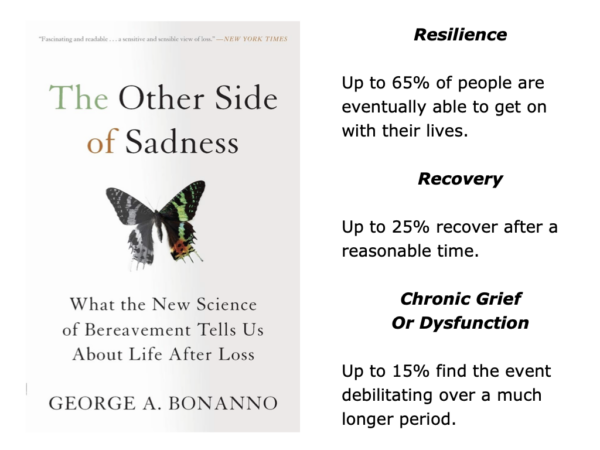
George found little evidence that people go through the stages outlined by Elisabeth Kübler-Ross. These are Denial, Anger, Bargaining, Depression and Acceptance.
This model has helped many people but, as mentioned earlier, Elisabeth studied people who knew they were dying. George focused on those who had been affected by life-changing events.
He reported that some people felt relieved when told it was okay to not necessarily to go through the classic stages. George found that:
There is no standard way of grieving.
Some people veer between sadness and more hopeful feelings. They have deep lows, but sometimes they might laugh and enjoy aspects of life. George also says something that sounds counter intuitive.
Sadness can help us to deal with the situation. When we are sad we turn inwards. We slow down. Our heartbeat gets slower.
We pay more attention to things in a more accurate way. This enables us to focus on what is important when making decisions.
Our states of sadness come and go. Sometimes we have other emotions, such as laughter and positivity. Staying sad for months on end overloads our system, however, and can lead to chronic depression.
People who experience grief sometimes feel great pain in their gut. This can affect their whole being. Sometimes this results in them feeling unreal, losing their appetite or having other symptoms.
They want to feel in control and for things to be as they were before. Panu Pihkala highlighted this reaction in a piece he wrote for the BBC website when describing people’s responses to climate change. Here is an excerpt from his article.
Grief researchers William Worden and Thomas Attig defined that one of the key tasks in a grief process is “the adjustment to a new environment”.
They depicted the whole grief process as “relearning the world”. Something has profoundly changed, something or someone is either lost or in the process of going away, and grief can help to us adjust.
Worden and Attig often had in mind the loss of a loved one, usually a human being. But these definitions match the needed scale of climate grief.
The world around us has changed, and is changing still.
We need to adjust to a new kind of social and ecological environment, with ongoing social disputes around climate politics and the ongoing physical effects of climate change.
We need to relearn the world: it is not like it was, or like we thought it was.
Many people recognise the importance of mourning. They may also recognise, however, that some feelings never go away. This sometimes calls for learning how to manage the emotions.
Some people honour the joy they got from a loved one. They may continue to speak to them and share what they are doing in their present life. This can be a way to celebrate the experiences they had together.
Some people learn how to manage the triggers that can lead them back into sadness. Sometimes they take time to recover but, after a while, they do something to give themselves positive energy in their lives.
Some people focus on how to make good use of the emotions. They may choose to appreciate life and help others to do the same. Some go further and move on to the following theme.
Mobilising
During the past 50 years I have worked with some individuals who have experienced grief and fallen into depression. One of the hardest parts is for them to mobilise their energy and start moving again.
The first step is a psychological one that only they can take. It is to choose to focus on what they can control rather than what they can’t control.
The second step is to explore how they may use the experience to help themselves or other people. They may then begin experiencing more positive feelings as they look at the possibilities.
The third step is to translate their ideas into positive actions and get some successes. At times they may slip back into depression, but they can then aim to do things that give them positive energy.
Some people translate their grief into doing good work. Some use it support others who go through similar experiences. Some use it to do practical work to help other people or care for the planet.
One approach is for them to build on their assets rather than their angst. They can then use these assets to help themselves and other people. Let’s look at two practical examples of taking this approach.
Chad Varah – The Samaritans
Chad was an Anglican clergyman who founded the Samaritans in 1953. Suicide was illegal at the time and he felt something could be done to help people in distress. Here is an excerpt from the organisation’s website. It explains Chad’s motivation.
The first funeral Chad Varah took as a curate prompted his lifelong commitment to suicide prevention and education.
The funeral was for a 13-year-old girl who had taken her own life because she feared she was seriously ill; in fact she had started to menstruate.
Chad vowed at her graveside to devote himself to helping other people overcome the sort of ignorance and isolation that had ultimately caused the young girl’s death.

Chad was born in Lincolnshire and studied at Oxford before attending Lincoln Theological College. He was ordained in 1936, then worked as curate in various parts of the UK before serving much of his working life in London.
Always daring to be different, he supplemented his early income by working as a children’s comic scriptwriter. He helped to create Dan Dare, the spaceman, for The Eagle comic. The official Samaritans site explains more about his approach.
An early proponent of sex education, Chad Varah alerted society to the approach of the permissive society, usually associated with the 1960s, with an article in the Picture Post in 1952.
Far more important to him than the outraged responses of conservative society were the 235 people who wrote in afterwards to bare their souls, 14 of whom showed signs of considering suicide.
The opportunity to act on his earlier promise to help people in emotional need came in 1953 when Chad was appointed Rector at the Church of St Stephen Walbrook in the City of London.
In the early 1950s, three suicides a day were officially recorded in Greater London; suicide was still an illegal act and sex education hardly existed.
Chad advertised in the press for people to help – not as trained counsellors, but as ordinary human beings offering a listening ear and emotional support.
Inundated with offers of help, he opened the first drop-in centre where emotionally isolated and distressed people could go to find a sympathetic ear – and Samaritans was born.
Chad continued to run Samaritans until 1987, thereafter remaining an active member of the organisation and retaining a watchful eye over it even after his retirement.
The Samaritans found that providing a listening ear could enable people to take more charge of their lives. Certainly some might use it as a constant emotional crutch, but it was still worth it, even if it helped only one person to live longer.
Chad pioneering work created a caring framework. This enabled many people to help themselves and live more fulfilling lives.
Joanna Macy – Active Hope
Joanna has devoted much of her life to helping people to manage their grief about climate change. She and Chris Johnstone produced the book Active Hope: How to face the mess we are in without going crazy. Here is an excerpt from the Introduction.
Whatever situation we face, we can choose our response. When facing overwhelming challenges, we might feel that our actions don’t count for much.
Yet the kind of responses we make, and the degree to which we believe they count, are shaped by the way we think and feel about hope.
Most books addressing global issues focus on describing either the problems we face or the solutions needed.
While we touch on both of these, our focus is on how we strengthen and support our intention to act, so that we can best play our part, whatever that may be, in the healing of our world.
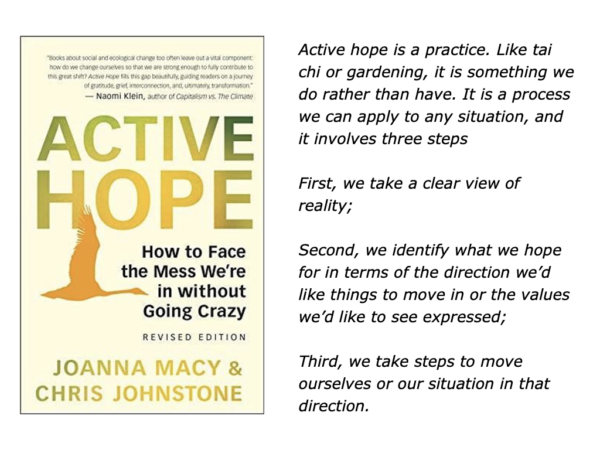
The structure of the book follows the four stages of: Gratitude, Honoring our Pain for the World, Seeing with New Eyes and Going Forth. The journey through these stages has a strengthening effect that deepens with every repetition.
Since Active Hope doesn’t require our optimism, we can apply it even in areas where we feel hopeless. The guiding impetus is intention: we choose what we aim to bring about, to act for, or express.
Rather than weighing our chances and proceeding only when we feel hopeful, we focus on our intention and let it be our guide.
Everybody will experience sorrow in their lives. Some people use this to mobilise their energy and move onto the next step.
Marvellous Work
The mainstream media is addicted to negative news. Look around the world, however, and there are thousands of stories about people who are doing good work.
Many have translated their challenging experiences into ways to help other people. They may run self-help groups, raise money for charities or do other kinds of marvellous work.
Deborah James was someone who did this in her own life. Here is an excerpt from a piece that Rachel Aroesti wrote in the Guardian about a TV programme that showed Debbie’s approach.
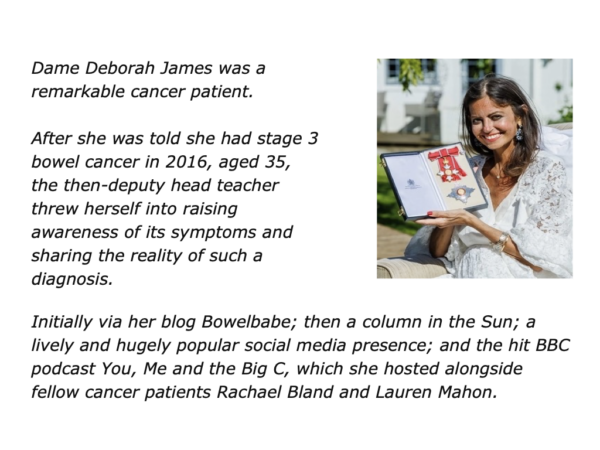
James did all this with equal parts glamour and candour – no easy task when you have “the poo cancer,” as she christened it on the podcast.
“There’s nothing pink about my cancer,” she continued wryly. “It’s just brown.”
Though clearly distraught, she signs off with her final broadcast with here humour undimmed. “Come on, I can’t leave on any other word apart from: check your poo.”
There are many ways to deal with challenging emotions. The feelings never go away but it may be possible to manage these. Some people do this by moving from mourning to mobilising to doing marvellous work.
Let’s return to your own life and work. Looking ahead, can you think of a situation where you may want to follow elements of this approach? How can you do this in your own way?
If you wish, try tackling the exercise on this theme. This invites you to complete the following sentences.
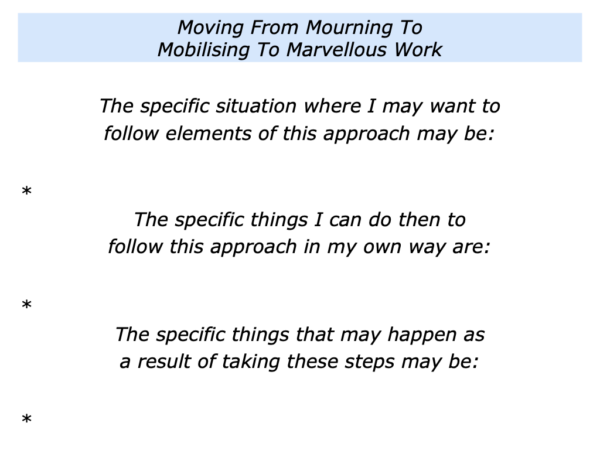


Leave a Reply